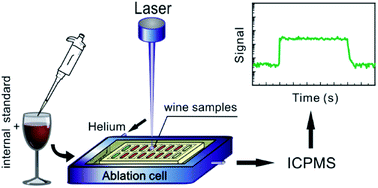Direct and rapid multi-element analysis of wine samples in their natural liquid state by laser ablation ICPMS†
Abstract
A simple and rapid method using laser ablation inductively coupled plasma mass spectrometry (LA-ICPMS) for direct multi-element analysis of wine samples without any sample pretreatment is described. Bestowed with its micro-sample consumption, the proposed method offers advantages of direct multi-element analysis in wine samples with high ethanol (1–20%) and salt contents, insignificant carbon deposits, reduced matrix effects, and better analytical performance. External calibration using either the solid reference material NIST 610 glass or aqueous standard solutions in combination with an indium internal standard provides accurate results. This calibration strategy offers a solution to the lack of a multi-element certified wine reference material for matrix-matched calibration. Twenty elements (Li, B, Mg, Al, V, Mn, Co, Cu, Zn, Rb, Sr, Y, Cs, Ba, La, Ce, Pr, Nd, Pb, and U) were determined in the wine samples. The proposed method was validated by a comparison with the conventional solution nebulization ICPMS method, with satisfying results. The detection limits for these elements were 0.01–1 ng mL−1. The proposed method also has great potential for multi-element analysis in other beverages.



 Please wait while we load your content...
Please wait while we load your content...